Asakusa Geisha Ozashiki Odori 浅草芸者のお座敷おどり
|
|
|
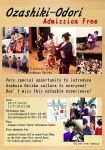
Asakusa geisha give free performances for tourists at the Asakusa Culture Tourist Information Center's 6th floor hall on Saturdays during the warmer months, especially April and Nov.Two shows on each Saturday at 1 pm and 2:30 pm. Free tickets are distributed on the day of the performance in the lobby of the Asakusa Culture Tourist Information Center from 10 am. The hall has only 75 seats and standing room for 30. See official website for the schedule: http://e-asakusa.jp/en/culture-experience/5890
|
|
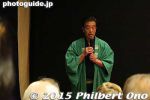
Shigemi Fuji, chairman of the Asakusa Tourist Federation greeted the full-house audience. 浅草観光連盟会長 冨士滋美
|
|
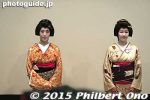
The geisha performers were introduced. Photos (without flash) and videos are permitted.
|
|
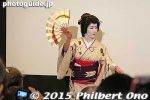
Ozashiki refers to a geisha party. So these dances are performed at geisha parties.
|
|

See my Youtube video showing the entire dancer performance.
|
|
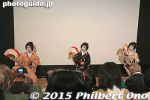
Asakusa geisha dancers (tachikata 立方) were Suzuryu (すず柳), Chifumi (千文), and Chino (千乃).
|
|
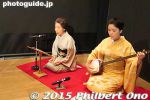
Musician and singer (jikata 地方) were Yuko (ゆう子), Tokyo's oldest geisha at age 92, and shamisen player Yoshiryo (よし涼).
|
|
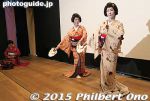
Momiji no Hashi (紅葉の橋). Song describing the season's transition from late autumn to early winter. Set next to a bridge with maple leaves.
|
|
|
|
|
|
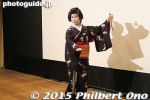
Namiki Komagata (並木駒形)Song about the gaudy, lively scenes along the route from Asakusa to Yoshiwara, home of the oiran courtesan. Asakusa Namiki roadside trees, Komagata, Hanakawado, Sanya-bori moat, and Dote Hatcho riverbank.
|
|
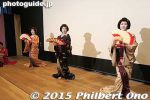
Asakusa Goyomi Autumn Version (浅草ごよみ 秋)Song about quaint autumn scenes in Asakusa's geisha district behind Sensoji temple. Matsuchiyama Shoten temple under the moonlight, small boat on a moat, etc. Also references Kisakata in Akita Prefecture made famous by Basho's Oku no Hosomichi.
|
|
|
|
|
|
|
|
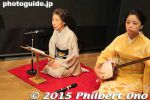
Tokyo's oldest geisha Yuko was an Asakusa geisha since age 16 and an unofficial Living Treasure of Asakusa. I was lucky to see her because she does not appear at every show.
|
|
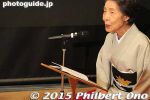
Yuko nee-san of Asakusa
|
|
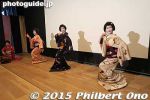
Asakusa Meibutsu (浅草名物)Song about Asakusa's many famous attractions like Matsuchiyama Shoten temple, Hanakawado, Hanayashiki Amusement Park, Sanja Matsuri, Sensoji temple, and Asakusa geisha.
|
|
|
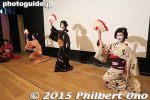
Sawagi (さわぎ)Song traditionally performed at the end of the geisha party (ozashiki). It expresses the joy of the geisha party and the sorrow of parting at the end. Song originated in Yoshiwara and spread to many geisha districts in Japan.
|
|
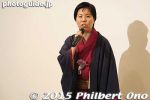
Hokan-gei (幇間芸) or Female male geisha (?)There used to be a few hundred male geisha in Japan. They were jesters providing comical entertainment. Now there are only seven of them, all in Asakusa. And she is the only female one. Call her a "female male geisha" (??).
|
|
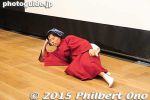
A day in the life of a struggling geisha...
|
|
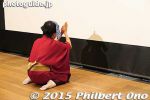
Praying for a geisha job.
|
|
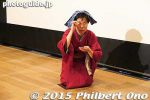
Putting on makeup.
|
|
|
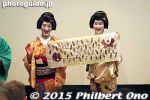
Geisha party game participants can win thishand towel printed with the names of Asakusa geisha.
|
|
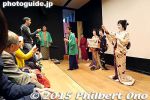
A few lucky foreigners (no Japanese allowed) from the audience participated in a geisha party game starting with jan ken po.
|
|
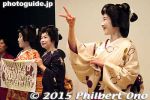
Rock, paper, scissors
|
|
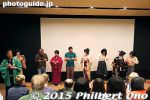
A string is attached to the middle of a stick and sake cup. You have to roll the stick until the sake cup reaches the stick.
|
|
|
|
|
|
|
|
|
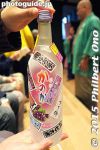
The winners of the party game got this unique bottle of sake bearing the name stickers of all the geisha who performed that day.
|
|
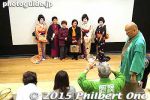
Afterward, some people could have their photo taken with the geisha.
|
|
|
|
|